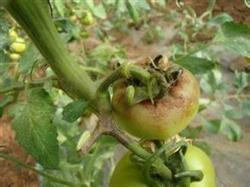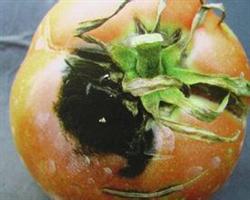How to identify tomato late blight

Late blight: the whole growth period and leaves, stems and fruits can be damaged, especially leaves and green fruits. The disease of seedlings generally appeared dark green watery spots from the leaves, and then extended to the stem, showing dark brown rot near the petiole. with the development of the disease, the base of the young stem was waterlogged constricted and the plant wilted and collapsed. In the adult stage, the disease began to develop upward from the lower leaves, from the leaf tip and leaf edge to produce dark green water-stained spots, gradually turned brown, and when the disease was serious, the whole plant leaves withered; the disease spots on the stem were brown or dark brown water stains, slightly sunken; fruit spots initially oily dark green, gradually changed to dark brown to brown, disease spots moire-like, rough hardening. White mildew layer can be produced in all the affected parts when it is moist. Precautions: 1. Sometimes the leaf disease spot is V-shaped from the leaf tip, or when the condition is not suitable, the disease part is dry, and there is no mildew layer, so it is easy to be confused with Botrytis cinerea when simple leaf disease occurs. 2. When the environmental conditions are especially suitable, the disease occurs rapidly, and there is no obvious disease spot in the leaves, but obvious white mildew appears. 3. Simple leaves are easy to be confused with frost injury, but frost injury occurs in the upper leaves. 4. Improper fertilization will also lead to the drying up of leaves similar to late blight, which begins from the lower leaves, but is evenly distributed in the whole field.
- Prev

What about cucumber deformity?
What about cucumber deformity?
- Next

How to Control physiological Diseases of Tomato
Physiological diseases often occur in the process of tomato cultivation, which have a great impact on the yield and quality. The most common are deformed fruit, hollow fruit, navel rot, fruit cracking, muscle rot, sunburn, poor coloring and so on. Deformed fruit. It mainly occurs in the period of flower bud differentiation and development, in low temperature and high fertilizer (especially nitrogen camp.
Related
- Where is it suitable to grow horseradish in China? it is expected to see the middle altitude horseradish in Alishan.
- How to prevent tomato virus disease reasonably? (Control methods included)
- Many people like to plant towel gourd on the balcony. What are the main points of this method and management?
- What crops can chili peppers be mixed with?
- Fertilization techniques and matters needing attention in Tomato
- What are the grafting techniques for peach seedlings in spring?
- Harm and control methods of root swelling disease of Chinese cabbage
- What are the pests of sweet potatoes? How to prevent and cure it?
- Symptoms, causes and Control methods of navel Rot in Tomato
- The cause of "Cucumber rotten bibcock" in Farmers' planting Cucumber and its Control Plan

